Friday, 14 July 2006
Distance 27 km
Duration 5 hours 20 minutes
Ascent 116 m, descent 130 m
Map 26 of the TOP100 blue series (now superseded)
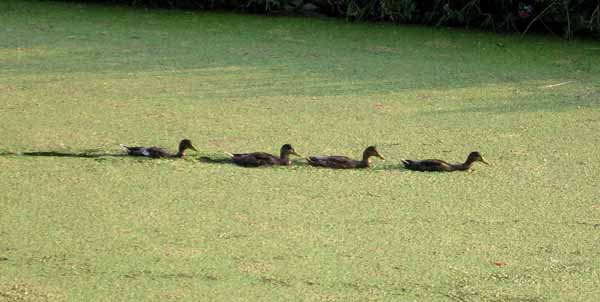
We left at 7:30 and immediately found ourselves on the tow path of the Canal d’Orléans, which differed from all the other canals we had met in that it was carpeted with thick green weed, through which ducks left trails as they paddled.
This canal, built in the seventeenth century to join Orléans with the Seine, had been abandoned in 1954, and the only traffic it now supported, apart from ducks, was pleasure craft.
The GR stayed close to the canal all the way into Orléans. It took a surprisingly long time (2 hours) to get to the first bridge, and as we approached the centre the path filled up with joggers and cyclists.
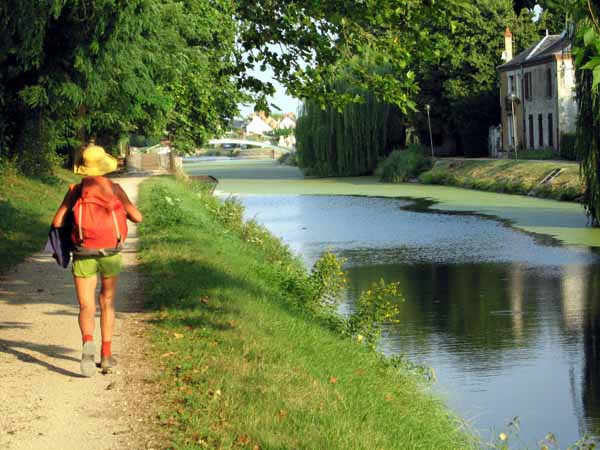
We mistook the first spire we saw for the cathedral, which caused us to turn up into the streets earlier than we should have.
It was a run-down area, but the inhabitants must have been encouraged by the fact that most of the roads had been dug up. Improvements were evidently on the way. There were many African restaurants and cafés, all closed.
We saw people carrying bread, so we walked the way they had come, and eventually found a boulangerie, but no bar.
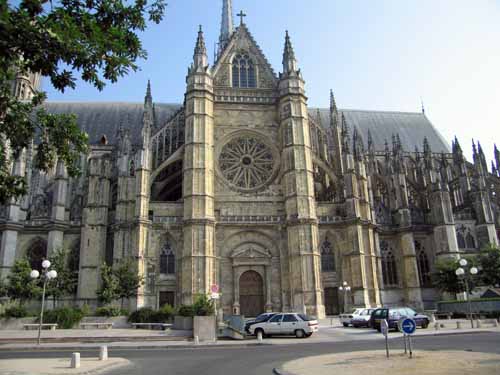
Soon afterwards we came to the actual cathedral in its huge square, with wide monumental boulevards radiating from it. The place was deserted, as it was Bastille Day, a public holiday, and apparently still too early for the tourist buses.
There were a couple of restaurants setting out their tables for lunch, but the rest of the establishments lining the main streets were offices and banks, all closed.
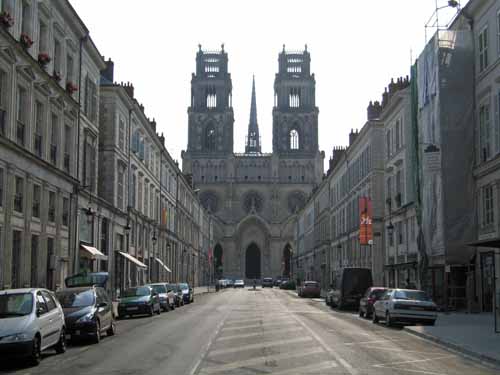
We set off towards the river again, taking to the side lanes, and before long we found a small shady square with a lovely bar, and had the pleasure of coffee and pastries under an awning. We also got our water bottles refilled.
With some reluctance we left this oasis and set off along the GR again, gradually losing the cyclists and joggers as we tramped further out of town.
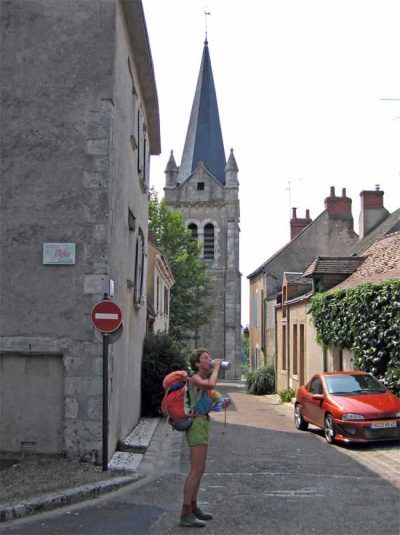
Before we were even out of the suburbs we came to a camping ground that was open (Saint-Jean-de-Ruelle), contrary to the information of our host at Chécy. But it did not look very attractive and we were not tempted to stay there.
Further down the river we came to the camping ground at La-Chapelle, which was indeed closed, although the locals were setting up tables there for a 14th of July feast. We went up hopefully to look for a bar in the village and there was one, but it was closed.
The walking was easy but it was beginning to drag by the time we got to Saint-Ay (universally referred to as Snay).
Before reaching the camping ground, we climbed up to the village, which turned out to be a few shops flanking the highway, with a scatter of houses behind. There were two bars but both were closed.
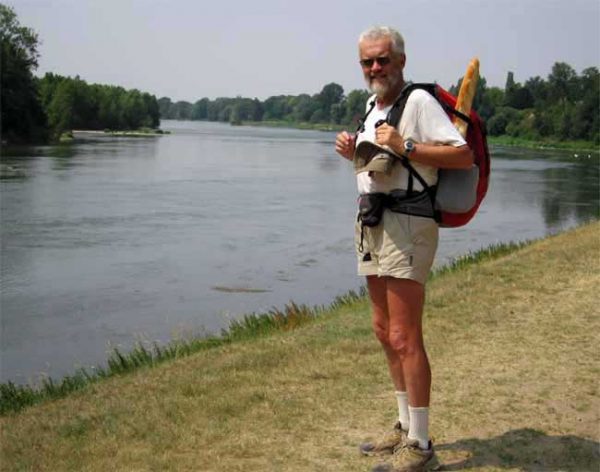
The two restaurants, on the other hand, were functioning, and we went into one to ask whether they would be open in the evening. Yes they would, but the camping ground was closed and so was the one at Meung.
This was a painful blow. It was too hot to contemplate walking all the way to Beaugency. Our best hope was to go and look at the camping ground with a view to camping there regardless.
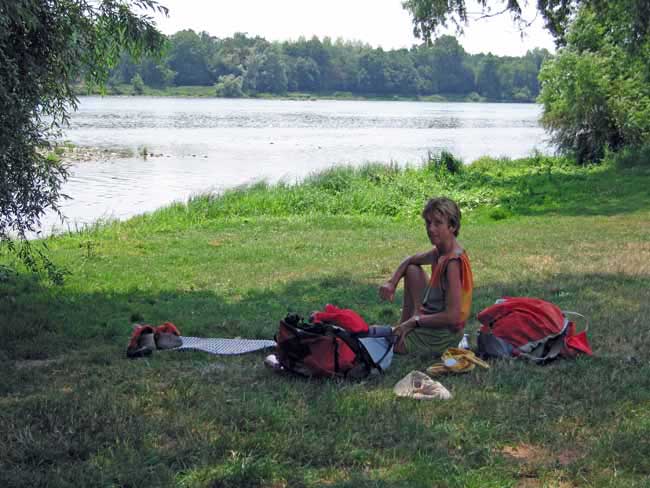
We found it down a staircase beside the river, vast and apparently fully maintained. The grass was newly mown, the hedges trimmed, but the shower block was locked and the taps cut off. It looked as though it had only closed last week.
For our purposes it was fine, except for the lack of water, but I ran back to the village and found a tap on the side of the Mairie, so we were able to have our lunch in comfort under a tree with no further anxiety. We enjoyed the cheeses from our lunch at Chécy with the fresh bread from Orléans.
Then we had a sleep, followed by a wash in the Loire. It did not qualify as a swim, as the water was no more than ankle deep. I wore all my walking clothes, to give them as well as myself a wash, forgetting that my pedometer was still attached to my shorts.
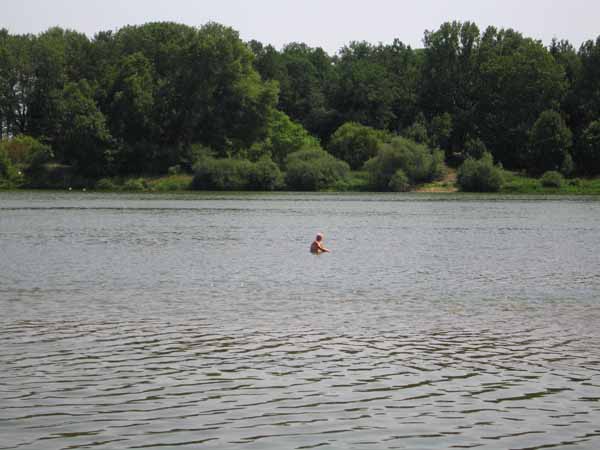
This did not do it any good – the screen went dead – but neither did it do it any lasting harm, as it gradually came back to life after a couple of hours.
A lot of people came through the camping ground during the afternoon, cycling or walking their dogs. Several of them stopped to chat, and to sympathise with us, although as one woman pointed out, at least it was cheap!
The general opinion was that tourists and visitors were treated appallingly in the region of Centre (“c’est un catastrophe!”).
Our only excursion was a visit to the modest Fontaine de Rabelais, just behind the camping ground, which recalls the visit of the great satirist to the village in 1542.
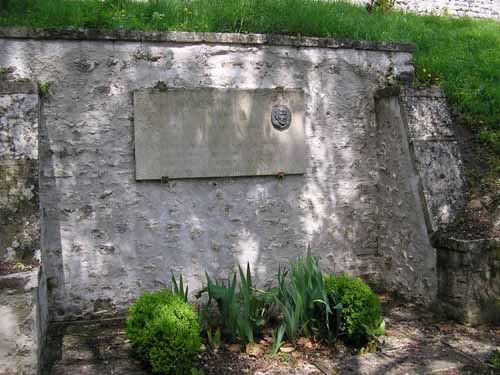
Rabelais personified much of what is now thought of as French – conviviality, a love of wine and food, and contempt for authority, especially ecclesiastical authority. He lived a long and interesting life and in his famous one-sentence will, he wrote, “I have nothing, I owe a great deal, and the rest I leave to the poor”.
Just before 8 o’clock, with the sun still well up in the sky, we hid our packs in the bushes near the water’s edge and went off to the village via the road. It soon became clear why we were the only strays who had arrived at the camping ground – there was a closed boom gate across the road entrance.
In the main street of Snay, the traffic was streaming through and both restaurants were open – the hotel and the Asian buffet.
The hotel was rather too elegant and expensive for people in ragged walking shorts, but on the other hand our previous experience of Asian food in France had been uninspiring. We finally decided on the latter and ended up thoroughly enjoying it.
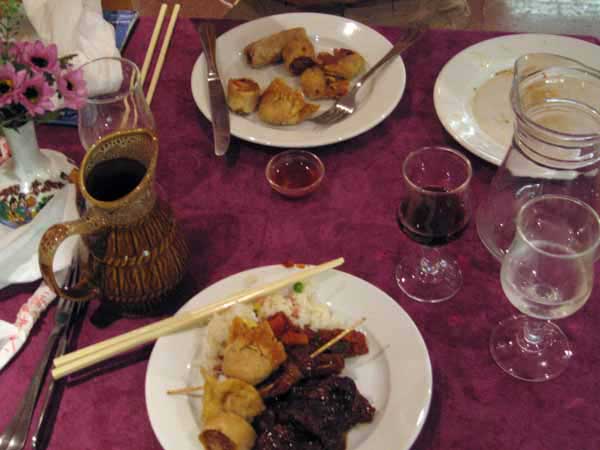
The place was run by a plump Thai woman, who shook hands with her many arriving guests and presented each one with prawn crackers and a glass of something pink and sweet. There was no menu, just an array of cabinets full of all sorts of things.
We applied ourselves with enthusiasm, first to the cold vegetables, salads and paper rolls, then to the hot dumplings, spring rolls and wontons, then to various spicy dishes with rice, and finally to fruit, icecream and strange Asian desserts such as tapioca soup. The price was €20 each for whatever you could eat.
We returned to the empty expanse of the camping ground as dusk was falling, put up the tent and retired. The distant boom of the fireworks in Orléans shook the ground but we were not otherwise disturbed. An orange half-moon rose about midnight.
Previous day: Châteauneuf-sur-Loire to Chécy